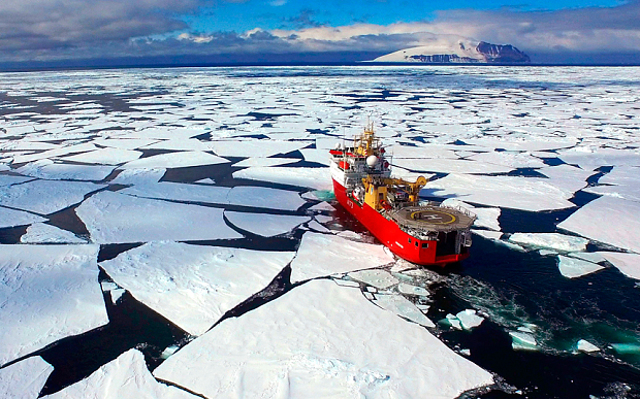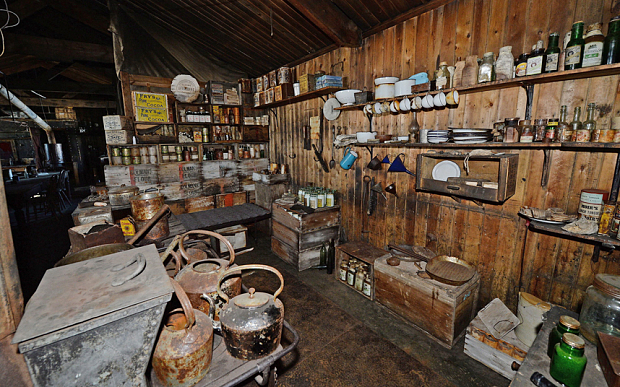HMS Protector is the first Royal Navy, or UK Government, vessel to have visited the region in 80 years or to have travelled so far south having dipped below 77 degrees latitude.
Her mission has been to support the work of the Convention for the Conservation of Antarctic Marine Living Resources (CCAMLR) in protecting the unique Antarctic eco-system through close co-operation with Australia and New Zealand.

During her patrol Protector inspected a number of fishing vessels to ensure they adhere to the strict licensing regulations in the area.
In addition the ship also paid a visit to the Italian Antarctic research station, Mario Zucchelli, while members of the ship’s company paid homage to the legendary British Antarctic explorers; Captain Robert Falcon Scott RN and Sir Ernest Shackleton.

“This was my first station visit and it was fascinating to see how the team supported themselves in such an inhospitable environment.” said Warrant Officer Jimmy Stuart
The UK is a founding signatory of the Antarctic Treaty and takes its responsibilities in the region very seriously – determined to uphold the key tenets of the Treaty of protecting the environment and preserving the area for scientific research.
Within 24 hours of arriving in the Ross Sea, the ice patrol ship had carried out the first of several CCAMLR inspections with six embarked Australian and New Zealand specialists to support.
Lieutenant Commander Ross Hickey, of the Royal New Zealand Navy, said: “It was a pleasure and a privilege to join HMS Protector in the Southern Ocean patrol and to the Ross Sea, particularly due to New Zealand’s involvement in heroic Antarctic exploration in both Scott’s and Shackleton’s expeditions.
“New Zealand is looking forward to hosting Protector when she visits our country later in the month.”
While in the Ross Sea, Protector visited the Antarctic research station, Mario Zucchelli, on the shores of Terra Nova Bay where Italian scientists proudly showed their facility.
Warrant Officer Jimmy Stuart, Protector’s deputy marine engineering officer, said: “This was my first station visit and it was fascinating to see how the team supported themselves in such an inhospitable environment. It is one of our roles to visit stations in order to build up good relationships amongst the Antarctic Treaty nations.
“While it was a bright sunny day when we visited, we have become all too aware of how quickly the weather can turn nasty down here.”
During the Austral Summer, the Ross Sea can lose most of its ice and it is possible for ships to push further south than anywhere else on the continent.
It was from this region that the great Antarctic explorers mounted their expeditions to reach the South Pole.
The legendary Norwegian explorer, Roald Amundsen started the journey that led him to being the first person to reach the South Pole from the Ross Ice Shelf.
Similarly, the British explorers, Captain Robert Scott and Sir Ernest Shackleton commenced their epic journeys from the Ross Sea including Scott’s fateful final expedition in 1911/12.
In honour of Scott, Shackleton, and the men they led, many of Protector’s ship’s company visited the huts they used as their base stations.

Image: The kitchen inside Captain Robert Falcon Scott's hut, Cape Evans
Protector’s ship’s company were granted permission to visit Scott’s hut at Cape Evans by the New Zealand Antarctic Heritage Trust.
The embarked New Zealand Defence Force liaison officer, Lt Cdr Hickey, acted as guide for the visit and the sailors got to witness a scene that had been untouched in years.
Fur boots and skis lay where they had been left, the wooden bunks still have their sleeping bags and clothes were hung over stoves, as if drying in the warmth.

Image: An inscription inside Captain Robert Falcon Scott's hut
It was there that Protector’s chaplain, Rev Andrew Allcock, held a remembrance service in memory of those who died during their return journey from the Pole.
Lieutenant Kate Retallick, operations officer 2, said: “It was a very poignant service outside Captain Scott’s hut for all of us. It is humbling to think of what they went through in the name of discovery.”
After the visit to Scott’s hut the ship went on to pay respect to Sir Ernest Shackleton and his team – fifteen miles to the north, another visit facilitated by the New Zealand Antarctic Heritage Trust.

Image: L/Cpl Ben Roberts (front) and Marine Luke Bright trekking from HMS Protector
By visiting this region Protector achieved a latitude of 77 Degrees 56 Minutes South – the very edge of the vast Ross Ice Shelf, named for James Clark Ross who led the exploration of the area.

Image: HMS Protector operating off Cape Evans
No official British ship has been this far south since 1936 and it is believed not since James Clark Ross’s own expedition in 1842.
Able Seaman Jumper Collins said: “Protector is my first ship and to have joined her in Australia and see the Antarctic in my first month on board has been amazing.”
Source: www.royalnavy.mod.uk